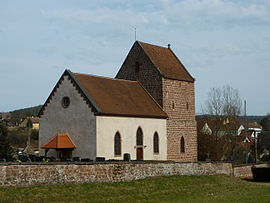Wimmenau
|
Wimmenau Wìmmenau |
||
|---|---|---|

Église Saint-André (Church of Saint Andrew), erected in 1681.
|
||
|
||
| Coordinates: 48°54′47″N 7°25′26″E / 48.9131°N 7.4239°ECoordinates: 48°54′47″N 7°25′26″E / 48.9131°N 7.4239°E | ||
| Country | France | |
| Region | Grand Est | |
| Department | Bas-Rhin | |
| Arrondissement | Saverne | |
| Canton | Ingwiller | |
| Intercommunality | Pays Petite Pierre | |
| Government | ||
| • Mayor (2014-2020) | Marc Ruch | |
| Area1 | 20.76 km2 (8.02 sq mi) | |
| Population (2014)2 | 1,125 | |
| • Density | 54/km2 (140/sq mi) | |
| Time zone | CET (UTC+1) | |
| • Summer (DST) | CEST (UTC+2) | |
| INSEE/Postal code | 67535 /67290 | |
| Elevation | 197–413 m (646–1,355 ft) (avg. 205 m or 673 ft) |
|
| Website | http://www.wimmenau.fr | |
|
1 French Land Register data, which excludes lakes, ponds, glaciers > 1 km² (0.386 sq mi or 247 acres) and river estuaries. 2Population without double counting: residents of multiple communes (e.g., students and military personnel) only counted once. |
||
1 French Land Register data, which excludes lakes, ponds, glaciers > 1 km² (0.386 sq mi or 247 acres) and river estuaries.
Wimmenau is a commune in the Bas-Rhin department in Grand Est in north-eastern France.
Wimmenau is located at the crossroads of an ancient Celtic road from Haguenau to Sarre-Union and an ancient Roman road from Strasbourg to Sarrebruck. It was mentioned for the first time in 836 (as Wimmenawe). In 1365, during the Hundred Years War, a hill near the village was used by English soldiers to monitor the Sparsbach and Moder Valleys and named "Englishberg".
The village was levelled during the Thirty Years War (1618–1648), except for the bell-tower of the Church of Saint Andrew, and was resettled by Swiss immigrants from the Bern area in the mid-seventeenth century. Before the war, the town had 30 inhabitants. From 1637-1655, there was not a single bourgeois (middle-class inhabitant) in the town, which had 30 bourgeois before the war. As with most of the Alsace region, Wimmenau came under the rule of France in 1680. The lack of farmland led to the emigration of many of the commune's inhabitants to the United States and Argentina during the nineteenth century. Alsace became part of the German Empire through the Treaty of Frankfurt in 1871, but was returned to France by the Treaty of Versailles in 1919. The town came under German administration again during World War II until it was liberated by American troops on 5-6 December 1944.
The town contains two national heritage sites (monuments historique). The Church of Saint Andrew (Église Saint-André), also known as the Protestant Church (Église protestante), was designated as a monument historique in 1995. Its bell-tower and chancel dates to the 12th century and was equipped with a ribbed vault in the 15th century. The church's nave—main building—was rebuilt after 1681 and expanded in 1878. A house built in 1669 (with additions in 1718) by the Scherer brothers—Swiss immigrants—with an adjacent oil mill dating to 1837 was added in 1984. The Scherer house, oil mill, and a few additional outbuildings form a complex which house historical artifacts related to rural life in the area.
...
Wikipedia



